Rhodiola/Cordyceps-Based Herbal Supplement Promotes Endurance Training-Improved Body Composition But Not Oxidative Stress and Metabolic Biomarkers: A Preliminary Randomized Controlled Study
Abstract
1. Introduction
2. Materials and Methods
2.1. Participants
2.2. Experimental Design
2.3. Maximal Oxygen Uptake (VO2max)
2.4. Major Chemical Compound Analyses of Rhodiola/Cordyceps
2.5. Eight-Week Training Program
2.6. Anthropometric Measurements
2.7. Hematological Analyses
2.8. TBARS and TAC Analyses
2.9. Statistical Analysis
3. Results
3.1. Characteristics of Participants
3.2. Body Composition Assessment
3.3. VO2max, Metabolic Parameters and Oxidative Stress Markers Assessment
4. Discussion
5. Conclusions
Author Contributions
Funding
Acknowledgments
Conflicts of Interest
References
- Biswas, A.; Oh, P.I.; Faulkner, G.E.; Bajaj, R.R.; Silver, M.A.; Mitchell, M.S.; Alter, D.A. Sedentary time and its association with risk for disease incidence, mortality, and hospitalization in adults: A systematic review and meta-analysis. Ann. Intern. Med. 2015, 162, 123–132. [Google Scholar] [CrossRef] [PubMed]
- De Rezende, L.F.M.; Lopes, M.R.; Rey-Lopez, J.P.; Matsudo, V.K.R.; Luiz, O.D.C. Sedentary Behavior and Health Outcomes: An Overview of Systematic Reviews. PLoS ONE 2014, 9, e105620. [Google Scholar] [CrossRef] [PubMed]
- Owen, N.; Sparling, P.B.; Healy, G.N.; Dunstan, D.W.; Matthews, C.E. Sedentary Behavior: Emerging Evidence for a New Health Risk. Mayo Clin. Proc. 2010, 85, 1138–1141. [Google Scholar] [CrossRef] [PubMed]
- Wilmot, E.G.; Edwardson, C.L.; Achana, F.A.; Davies, M.J.; Gorely, T.; Gray, L.J.; Khunti, K.; Yates, T.; Biddle, S.J.H. Sedentary time in adults and the association with diabetes, cardiovascular disease and death: Systematic review and meta-analysis. Diabetologia 2012, 55, 2895–2905. [Google Scholar] [CrossRef] [PubMed]
- Patterson, R.; McNamara, E.; Tainio, M.; De Sá, T.H.; Smith, A.D.; Sharp, S.J.; Edwards, P.; Woodcock, J.; Brage, S.; Wijndaele, K. Sedentary behaviour and risk of all-cause, cardiovascular and cancer mortality, and incident type 2 diabetes: A systematic review and dose response meta-analysis. Eur. J. Epidemiol. 2018, 33, 811–829. [Google Scholar] [CrossRef]
- Warburton, D.E.; Nicol, C.W.; Bredin, S.S. Health benefits of physical activity: The evidence. Can. Med. Assoc. J. 2006, 174, 801–809. [Google Scholar] [CrossRef] [PubMed]
- Durstine, J.L.; Grandjean, P.W.; Davis, P.G.; Ferguson, M.A.; Alderson, N.L.; DuBose, K.D. Blood lipid and lipoprotein adaptations to exercise: A quantitative analysis. Sports Med. 2001, 31, 1033–1062. [Google Scholar] [CrossRef]
- Williamson, D.F.; Madans, J.; Anda, R.F.; Kleinman, J.C.; Kahn, H.S.; Byers, T. Recreational physical activity and ten-year weight change in a US national cohort. Int. J. Obes. Relat. Metab. Disord. 1993, 17, 279–286. [Google Scholar]
- Sallam, N.; Laher, I. Exercise Modulates Oxidative Stress and Inflammation in Aging and Cardiovascular Diseases. Oxidative Med. Cell. Longev. 2016, 2016, 7239639. [Google Scholar] [CrossRef]
- Jeon, C.Y.; Lokken, R.P.; Hu, F.B.; Van Dam, R.M. Physical Activity of Moderate Intensity and Risk of Type 2 Diabetes: A systematic review. Diabetes Care 2007, 30, 744–752. [Google Scholar] [CrossRef]
- Sesso, H.D.; Paffenbarger, R.S.; Lee, I.M. Physical activity and coronary heart disease in men: The Harvard Alumni Health Study. Circulation 2000, 102, 975–980. [Google Scholar] [CrossRef] [PubMed]
- Meredith, C.N.; Frontera, W.R.; Fisher, E.C.; Hughes, V.A.; Herland, J.C.; Edwards, J.; Evans, W.J. Peripheral effects of endurance training in young and old subjects. J. Appl. Physiol. 1989, 66, 2844–2849. [Google Scholar] [CrossRef] [PubMed]
- Kitaoka, K.; Takeuchi, M.; Tsuboi, A.; Minato, S.; Kurata, M.; Tanaka, S.; Kazumi, T.; Fukuo, K. Increased Adipose and Muscle Insulin Sensitivity without Changes in Serum Adiponectin in Young Female Collegiate Athletes. Metab. Syndr. Relat. Disord. 2017, 15, 246–251. [Google Scholar] [CrossRef] [PubMed]
- Tiidus, P.M.; Pushkarenko, J.; Houston, M.E. Lack of antioxidant adaptation to short-term aerobic training in human muscle. Am. J. Physiol. Integr. Comp. Physiol. 1996, 271, R832–R836. [Google Scholar] [CrossRef]
- Cui, J.L.; Guo, T.T.; Ren, Z.X.; Zhang, N.S.; Wang, M.L. Diversity and antioxidant activity of culturable endophytic fungi from alpine plants of Rhodiola crenulata, R. angusta, and R. sachalinensis. PLoS ONE 2015, 10, e0118204. [Google Scholar] [CrossRef] [PubMed]
- Yang, X.; He, T.; Han, S.; Zhang, X.; Sun, Y.; Xing, Y.; Shang, H. The Role of Traditional Chinese Medicine in the Regulation of Oxidative Stress in Treating Coronary Heart Disease. Oxidative Med. Cell. Longev. 2019, 2019, 3231424. [Google Scholar] [CrossRef]
- Fan, Y.; Tan, R.; Jiang, L. Evaluation of treatment of 27 cases of type 2 diabetic patients with Rhodiola crenulata tea. Chin. J. Mod. Appl. Pharm. 2007, 1, 10–11. [Google Scholar]
- Kan, W.C.; Wang, H.Y.; Chien, C.C.; Li, S.L.; Chen, Y.C.; Chang, L.H.; Cheng, C.H.; Tsai, W.C.; Hwang, J.C.; Su, S.B.; et al. Effects of Extract from Solid-State Fermented Cordyceps sinensis on Type 2 Diabetes Mellitus. Evid. Based Complement. Altern. Med. 2012, 2012, 743107. [Google Scholar] [CrossRef][Green Version]
- Koh, J.-H.; Kim, J.-M.; Chang, U.-J.; Suh, H.-J. Hypocholesterolemic effect of hot-water extract from mycelia of Cordyceps sinensis. Biol. Pharm. Bull. 2003, 26, 84–87. [Google Scholar] [CrossRef]
- Nagata, A.; Tajima, T.; Uchida, M. Supplemental anti-fatigue effects of Cordyceps sinensis (tochu-kaso) extract powder during three stepwise exercise of human. Jpn. J. Phys. Fit. Sports Med. 2006, 55, S145–S152. [Google Scholar] [CrossRef]
- Wang, J.M.; Shan, J.P.; Wang, S.Q. Progress of research study on pharmacological action of Rhodiola rosea. ACMP Assoc. Chang. Manag. Prof. 2003, 31, 57–59. [Google Scholar]
- Panossian, A.; Hamm, R.; Wikman, G.; Efferth, T. Mechanism of action of Rhodiola, salidroside, tyrosol and triandrin in isolated neuroglial cells: An interactive pathway analysis of the downstream effects using RNA microarray data. Phytomedicine 2014, 21, 1325–1348. [Google Scholar] [CrossRef] [PubMed]
- Chiang, H.M.; Chien, Y.C.; Wu, C.H.; Kuo, Y.H.; Wu, W.C.; Pan, Y.Y.; Su, Y.H.; Wen, K.C. Hydroalcoholic extract of Rhodiola rosea L. (Crassulaceae) and its hydrolysate inhibit melanogenesis in B16F0 cells by regulating the CREB/MITF/tyrosinase pathway. Food. Chem. Toxicol. 2014, 65, 129–139. [Google Scholar] [CrossRef] [PubMed]
- Chiou, W.F.; Chang, P.C.; Chou, C.J.; Chen, C.F. Protein constituent contributes to the hypotensive and vasorelaxant activities of Cordyceps sinensis. Life Sci. 2000, 66, 1369–1376. [Google Scholar] [CrossRef]
- Chen, C.Y.; Hou, C.W.; Bernard, J.R.; Chen, C.C.; Hung, T.C.; Cheng, L.L.; Liao, Y.H.; Kuo, C.H. Rhodiola crenulata- and Cordyceps sinensis-Based Supplement Boosts Aerobic Exercise Performance after Short-Term High Altitude Training. High Alt. Med. Biol. 2014, 15, 371–379. [Google Scholar] [CrossRef] [PubMed]
- Colson, S.N.; Wyatt, F.B.; Johnston, D.L.; Autrey, L.D.; Fitzgerald, Y.L.; Earnest, C.P. Cordyceps sinensis- and Rhodiola rosea-based supplementation in male cyclists and its effect on muscle tissue oxygen saturation. J. Strength Cond. Res. 2005, 19, 358–363. [Google Scholar]
- Storer, T.W.; A Davis, J.; Caiozzo, V.J. Accurate prediction of VO2max in cycle ergometry. Med. Sci. Sports Exerc. 1990, 22, 704–712. [Google Scholar] [CrossRef] [PubMed]
- Ahmed, M.; Henson, D.A.; Sanderson, M.C.; Nieman, D.C.; Zubeldia, J.M.; Shanely, R.A. Rhodiola rosea Exerts Antiviral Activity in Athletes Following a Competitive Marathon Race. Front. Nutr. 2015, 2, 24. [Google Scholar] [CrossRef]
- Kang, D.Z.; Hong, H.D.; Kim, K.I.; Choi, S.Y. Anti-Fatigue Effects of Fermented Rhodiola rosea Extract in Mice. Prev. Nutr. Food Sci. 2015, 20, 38–42. [Google Scholar] [CrossRef]
- Ballmann, C.G.; Maze, S.B.; Wells, A.C.; Marshall, M.M.; Rogers, R.R. Effects of short-term Rhodiola Rosea (Golden Root Extract) supplementation on anaerobic exercise performance. J. Sports Sci. 2019, 37, 998–1003. [Google Scholar] [CrossRef]
- Parisi, A.; Tranchita, E.; Duranti, G.; Ciminelli, E.; Quaranta, F.; Ceci, R.; Cerulli, C.; Borrione, P.; Sabatini, S. Effects of chronic Rhodiola Rosea supplementation on sport performance and antioxidant capacity in trained male: Preliminary results. J. Sports Med. Phys. Fit. 2010, 50, 57–63. [Google Scholar]
- Walker, T.B.; Altobelli, S.A.; Caprihan, A.; Robergs, R.A. Failure of Rhodiola rosea to alter skeletal muscle phosphate kinetics in trained men. Metabolism 2007, 56, 1111–1117. [Google Scholar] [CrossRef] [PubMed]
- Jowko, E.; Sadowski, J.; Dlugolecka, B.; Gierczuk, D.; Opaszowski, B.; Cieslinski, I. Effects of Rhodiola rosea supplementation on mental performance, physical capacity, and oxidative stress biomarkers in healthy men. J. Sport Health Sci. 2018, 7, 473–480. [Google Scholar] [CrossRef] [PubMed]
- Hirsch, K.R.; Smith-Ryan, A.E.; Roelofs, E.J.; Trexler, E.T.; Mock, M.G. Cordyceps militaris improves tolerance to high-intensity exercise after acute and chronic supplementation. J. Diet Suppl. 2017, 14, 42–53. [Google Scholar] [CrossRef]
- Chen, S.; Li, Z.; Krochmal, R.; Abrazado, M.; Kim, W.; Cooper, C.B. Effect of Cs-4 (Cordyceps sinensis) on Exercise Performance in Healthy Older Subjects: A Double-Blind, Placebo-Controlled Trial. J. Altern. Complement. Med. 2010, 16, 585–590. [Google Scholar] [CrossRef] [PubMed]
- Yan, F.; Wang, B.; Zhang, Y. Polysaccharides from Cordyceps sinensis mycelium ameliorate exhaustive swimming exercise-induced oxidative stress. Pharm. Biol. 2014, 52, 157–161. [Google Scholar] [CrossRef]
- Kumar, R.; Negi, P.; Singh, B.; Ilavazhagan, G.; Bhargava, K.; Sethy, N.K. Cordyceps sinensis promotes exercise endurance capacity of rats by activating skeletal muscle metabolic regulators. J. Ethnopharmacol. 2011, 136, 260–266. [Google Scholar] [CrossRef] [PubMed]
- Sen, C.K.; Marin, E.; Kretzschmar, M.; Hänninen, O. Skeletal muscle and liver glutathione homeostasis in response to training, exercise, and immobilization. J. Appl. Physiol. 1992, 73, 1265–1272. [Google Scholar] [CrossRef]
- Powers, S.K.; Criswell, D.; Lawler, J.; Martin, D.; Lieu, F.K.; Ji, L.L.; Herb, R.A. Rigorous exercise training increases superoxide dismutase activity in ventricular myocardium. Am. J. Physiol. Circ. Physiol. 1993, 265, H2094–H2098. [Google Scholar] [CrossRef]
- Evelo, C.T.A.; Palmen, N.G.M.; Artur, Y.; Janssen, G.M.E. Changes in blood glutathione concentrations, and in erythrocyte glutathione reductase and glutathione S-transferase activity after running training and after participation in contests. Graefe’s Arch. Clin. Exp. Ophthalmol. 1992, 64, 354–358. [Google Scholar] [CrossRef]
- Covas, M.I.; Elosua, R.; Fito, M.; Alcantara, M.; Coca, L.; Marrugat, J. Relationship between physical activity and oxidative stress biomarkers in women. Med. Sci. Sports Exerc. 2002, 34, 814–819. [Google Scholar] [CrossRef]
- Bergholm, R.; Mäkimattila, S.; Valkonen, M.; Liu, M.-L.; Lahdenperä, S.; Taskinen, M.-R.; Sovijärvi, A.; Malmberg, P.; Yki-Järvinen, H. Intense physical training decreases circulating antioxidants and endothelium-dependent vasodilatation in vivo. Atherosclerosis 1999, 145, 341–349. [Google Scholar] [CrossRef]
- De Sanctis, R.; De Bellis, R.; Scesa, C.; Mancini, U.; Cucchiarini, L.; Dachà, M. In vitro protective effect of Rhodiola rosea extract against hypochlorous acid-induced oxidative damage in human erythrocytes. BioFactors 2004, 20, 147–159. [Google Scholar] [CrossRef] [PubMed]
- Wing, S.L.; Askew, E.W.; Luetkemeier, M.J.; Ryujin, D.T.; Kamimori, G.H.; Grissom, C.K. Lack of effect of Rhodiola or oxygenated water supplementation on hypoxemia and oxidative stress. Wilderness Environ. Med. 2003, 14, 9–16. [Google Scholar] [CrossRef]
- Chen, T.S.; Liou, S.Y.; Chang, Y.L. Antioxidant Evaluation of Three Adaptogen Extracts. Am. J. Chin. Med. 2008, 36, 1209–1217. [Google Scholar] [CrossRef] [PubMed]
- Després, J.P.; Pouliot, M.C.; Moorjani, S.; Nadeau, A.; Tremblay, A.; Lupien, P.J.; Thériault, G.; Bouchard, C. Loss of abdominal fat and metabolic response to exercise training in obese women. Am. J. Physiol. Metab. 1991, 261, E159–E167. [Google Scholar] [CrossRef] [PubMed]
- Leon, A.S.; Conrad, J.; Hunninghake, D.B.; Serfass, R. Effects of a vigorous walking program on body composition, and carbohydrate and lipid metabolism of obese young men. Am. J. Clin. Nutr. 1979, 32, 1776–1787. [Google Scholar] [CrossRef] [PubMed]
- Woo, R.; Garrow, J.S.; Pi-Sunyer, F.X. Voluntary food intake during prolonged exercise in obese women. Am. J. Clin. Nutr. 1982, 36, 478–484. [Google Scholar] [CrossRef]
- Tremblay, A.; Simoneau, J.A.; Bouchard, C. Impact of exercise intensity on body fatness and skeletal muscle metabolism. Metabolism 1994, 43, 814–818. [Google Scholar] [CrossRef]
- Lin, K.T.; Hsu, S.W.; Lai, F.Y.; Chang, T.C.; Shi, L.S.; Lee, S.Y. Rhodiola crenulata extract regulates hepatic glycogen and lipid metabolism via activation of the AMPK pathway. BMC Complement. Altern. Med. 2016, 16, 127. [Google Scholar] [CrossRef]
- Pomari, E.; Stefanon, B.; Colitti, M. Effects of Two Different Rhodiola rosea Extracts on Primary Human Visceral Adipocytes. Molecules 2015, 20, 8409–8428. [Google Scholar] [CrossRef] [PubMed]
- Chen, X.; Wu, Y.; Yang, T.; Wei, M.; Wang, Y.; Deng, X.; Shen, C.; Li, W.; Zhang, H.; Xu, W.; et al. Salidroside alleviates cachexia symptoms in mouse models of cancer cachexia via activating mTOR signalling. J. Cachexia Sarcopenia Muscle 2016, 7, 225–232. [Google Scholar] [CrossRef] [PubMed]
- Zhong, X.; Lin, R.; Li, Z.; Mao, J.; Chen, L. Effects of Salidroside on cobalt chloride-induced hypoxia damage and mTOR signaling repression in PC12 cells. Biol. Pharm. Bull. 2014, 37, 1199–1206. [Google Scholar] [CrossRef] [PubMed]
- Song, J.; Wang, Y.; Teng, M.; Cai, G.; Xu, H.; Guo, H.; Liu, Y.; Wang, D.; Teng, L. Studies on the Antifatigue Activities of Cordyceps militaris Fruit Body Extract in Mouse Model. Evid. Based Complement. Altern. Med. 2015, 2015, 1–15. [Google Scholar]
- Urso, M.L.; Clarkson, P.M. Oxidative stress, exercise, and antioxidant supplementation. Toxicology 2003, 189, 41–54. [Google Scholar] [CrossRef]
- Gomez-Cabrera, M.-C.; Domenech, E.; Romagnoli, M.; Arduini, A.; Borras, C.; Pallardo, F.V.; Sastre, J.; Viña, J. Oral administration of vitamin C decreases muscle mitochondrial biogenesis and hampers training-induced adaptations in endurance performance. Am. J. Clin. Nutr. 2008, 87, 142–149. [Google Scholar] [CrossRef] [PubMed]
- Paulsen, G.; Cumming, K.T.; Holden, G.; Hallén, J.; Rønnestad, B.R.; Sveen, O.; Skaug, A.; Paur, I.; Bastani, N.E.; Østgaard, H.N.; et al. Vitamin C and E supplementation hampers cellular adaptation to endurance training in humans: A double-blind, randomised, controlled trial. J. Physiol. 2014, 592, 1887–1901. [Google Scholar] [CrossRef]
- Morrison, D.; Hughes, J.; Della Gatta, P.A.; Mason, S.; Lamon, S.; Russell, A.P.; Wadley, G.D. Vitamin C and E supplementation prevents some of the cellular adaptations to endurance-training in humans. Free Radic. Biol. Med. 2015, 89, 852–862. [Google Scholar] [CrossRef]
- Nikolaidis, M.G.; Kerksick, C.M.; Lamprecht, M.; McAnulty, S.R. Does vitamin C and E supplementation impair the favorable adaptations of regular exercise? Oxid. Med. Cell Longev. 2012, 2012, 707941. [Google Scholar] [CrossRef]
- Yuan, Y.; Wu, S.J.; Liu, X.; Zhang, L.L. Antioxidant effect of salidroside and its protective effect against furan-induced hepatocyte damage in mice. Food Funct. 2013, 4, 763–769. [Google Scholar] [CrossRef]
- Gudkov, S.V.; Shtarkman, I.N.; Smirnova, V.S.; Chernikov, A.V.; Bruskov, V.I. Guanosine and inosine display antioxidant activity, protect DNA in vitro from oxidative damage induced by reactive oxygen species, and serve as radioprotectors in mice. Radiat. Res. 2006, 165, 538–545. [Google Scholar] [CrossRef] [PubMed]
- Maggirwar, S.; Dhanraj, D.; Somani, S.; Ramkumar, V. Adenosine Acts as an Endogenous Activator of the Cellular Antioxidant Defense System. Biochem. Biophys. Res. Commun. 1994, 201, 508–515. [Google Scholar] [CrossRef] [PubMed]
- Ramkumar, V.; Hallam, D.M.; Nie, Z. Adenosine, Oxidative Stress and Cytoprotection. Jpn. J. Pharmacol. 2001, 86, 265–274. [Google Scholar] [CrossRef] [PubMed]
- Chen, J.; Zhang, W.; Lu, T.; Li, J.; Zheng, Y.; Kong, L. Morphological and genetic characterization of a cultivated Cordyceps sinensis fungus and its polysaccharide component possessing antioxidant property in H22 tumor-bearing mice. Life Sci. 2006, 78, 2742–2748. [Google Scholar] [CrossRef] [PubMed]
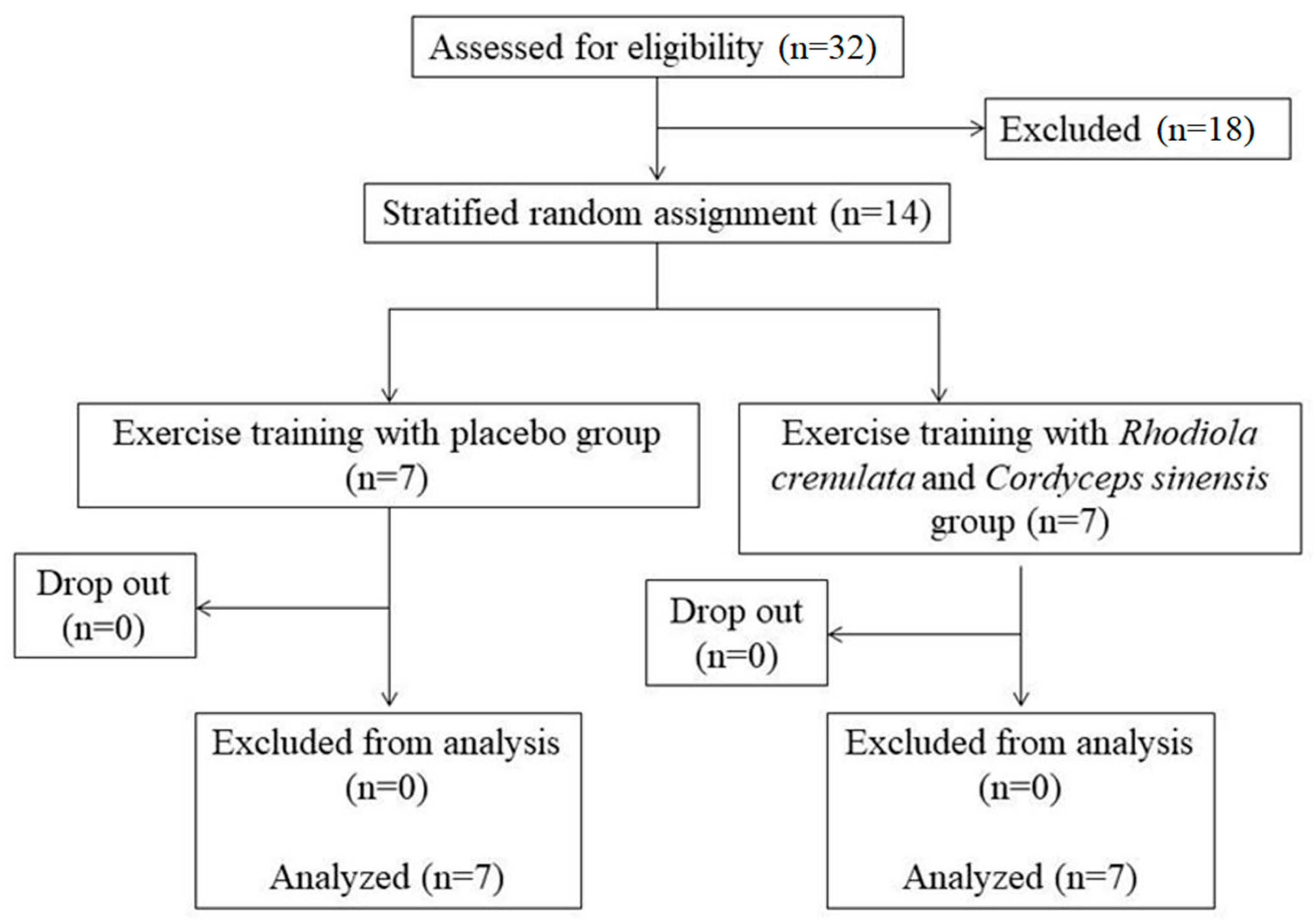
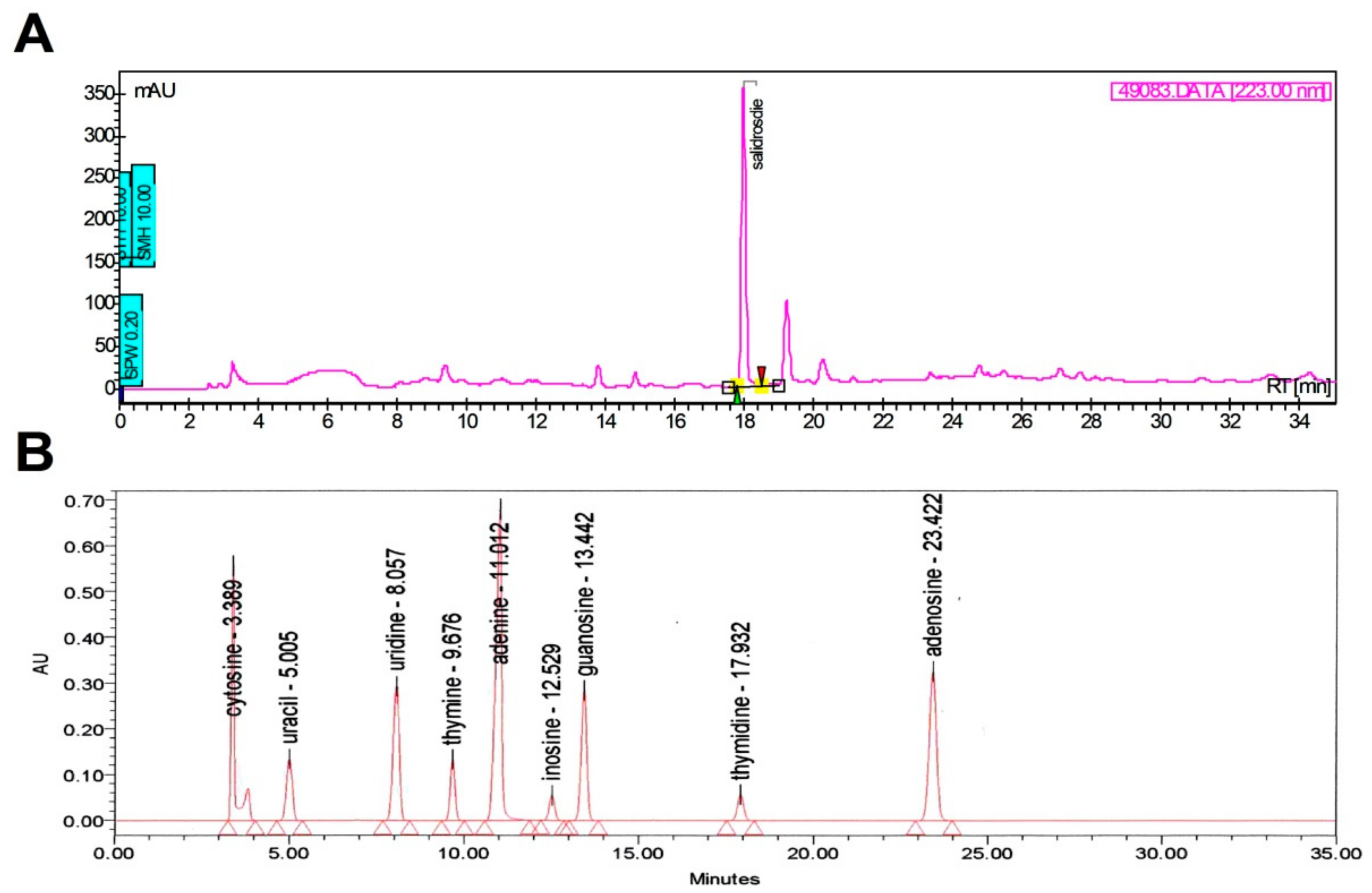
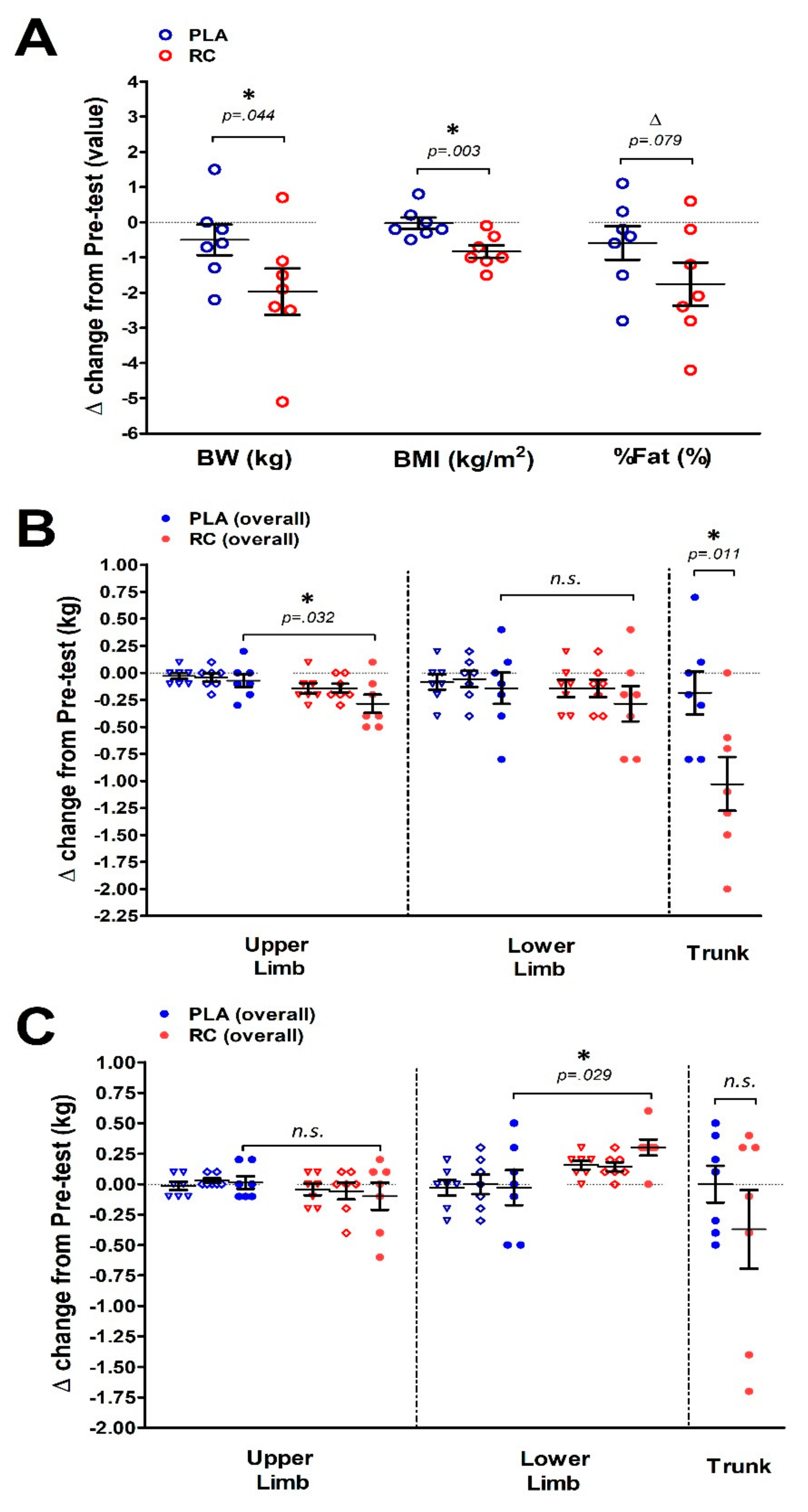
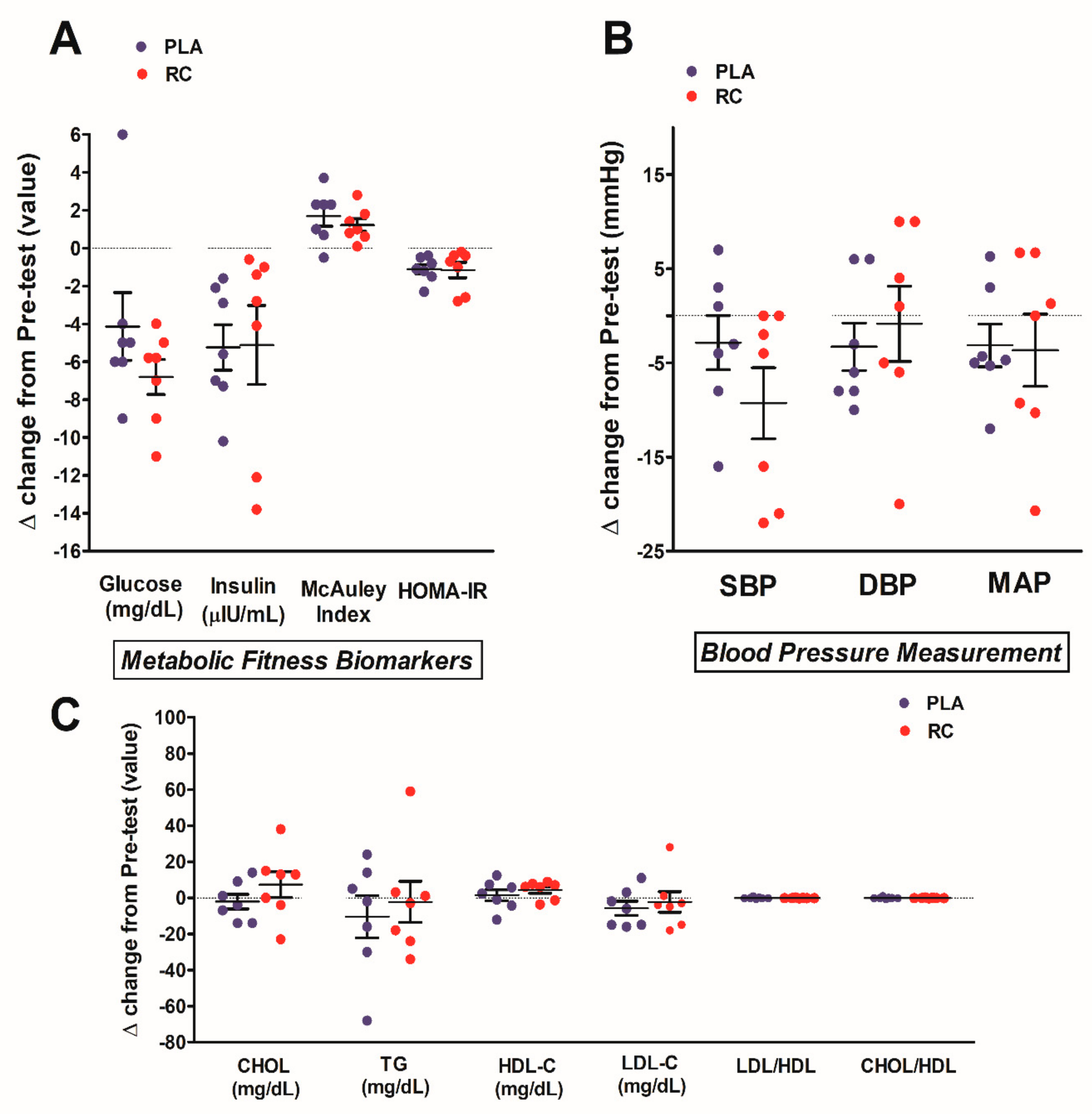
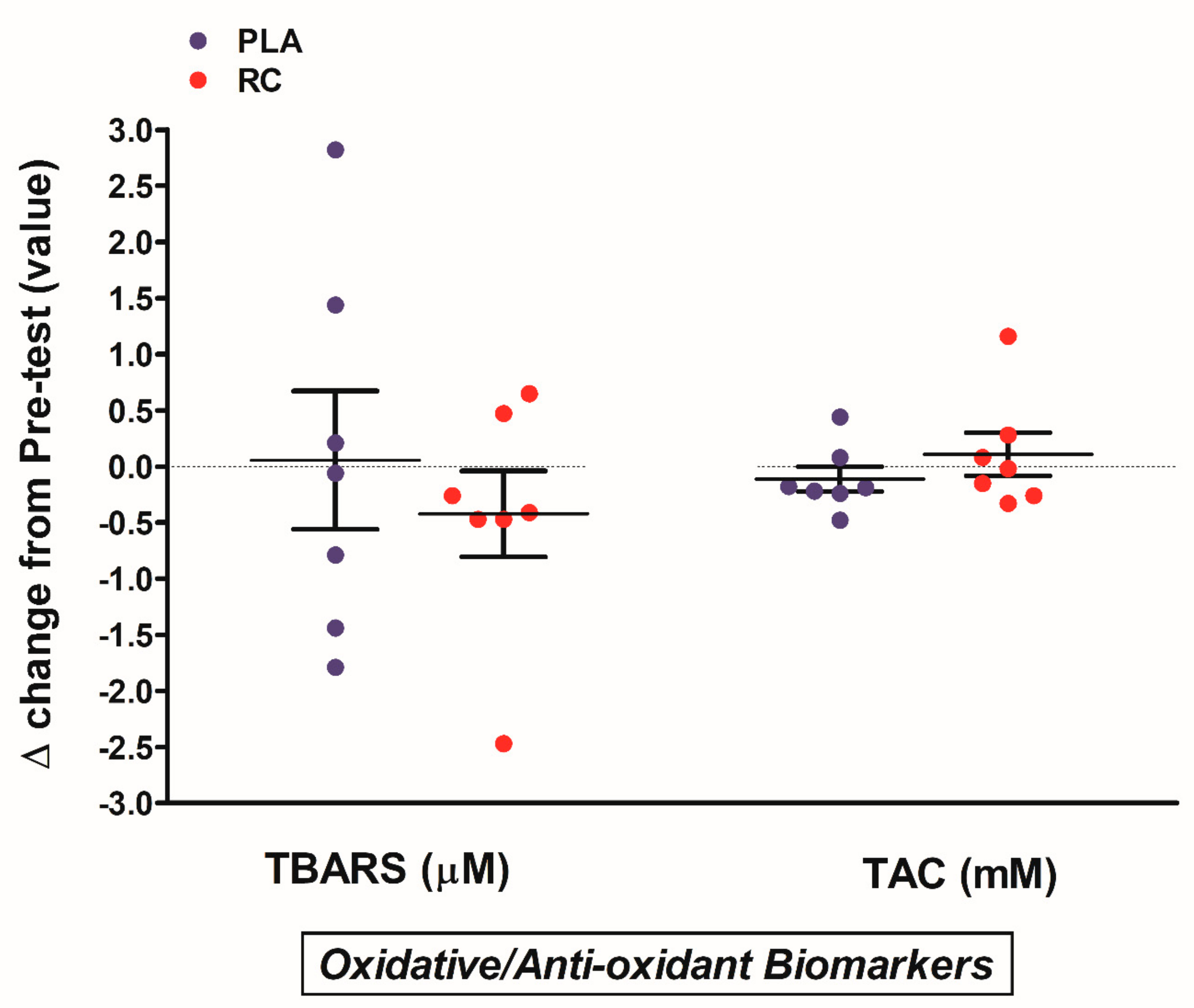
| Week | Frequency (times/week) | Intensity (%Wmax) | Duration (min) |
|---|---|---|---|
| Week 1 | 3 | 60 | 30/40/50 |
| Week 2 | 3 | 60 | 60 |
| Week 3 | 3 | 65 | 30/40/50 |
| Week 4 | 3 | 65 | 60 |
| Week 5 | 3 | 70 | 30/40/50 |
| Week 6 | 3 | 70 | 60 |
| Week 7 | 3 | 75 | 30/40/50 |
| Week 8 | 3 | 75 | 60 |
| Baseline Characteristics | PLA | RC |
|---|---|---|
| Gender (male: female) | 4 : 3 | 4 : 3 |
| Age (years) | 21.4 ± 0.4 | 21.7 ± 0.4 |
| Body weight (kg) | 69.7 ± 5.0 | 67.6 ± 4.8 |
| Height (cm) | 168.0 ± 2.3 | 167.7 ± 4.0 |
| VO2max (ml/kg/min) | 36.9 ± 2.2 | 35.4 ± 1.1 |
| Body Composition | PLA | RC | ||
|---|---|---|---|---|
| Assessment | Pre | Post | Pre | Post |
| Body weight (kg) | 69.7 ± 5.0 | 69.2 ± 5.4 | 67.6 ± 4.8 | 65.7 ± 4.8 † |
| BMI (kg/m2) | 24.6 ± 1.4 | 24.5 ± 1.5 | 23.9 ± 0.9 | 23.0 ± 2.3 † |
| Body fat (%) | 26.6 ± 2.8 | 26.0 ± 2.8 | 27.3 ± 2.8 | 25.5 ± 2.7 † |
| Skeletal muscle tissue | ||||
| Upper limbs (kg) | 5.4 ± 0.4 | 5.4 ± 0.4 | 5.3 ± 0.7 | 5.2 ± 0.7 |
| Lower limbs (kg) | 16.2 ± 1.0 | 16.3 ± 1.0 | 15.0 ± 1.6 | 15.3 ± 1.6 † |
| Trunk (kg) | 22.6 ± 1.2 | 22.6 ± 1.3 | 22.2 ± 2.3 | 21.9 ± 2.2 |
| Adipose tissue | ||||
| Upper limbs (kg) | 2.5 ± 0.5 | 2.4 ± 0.6 | 2.3 ± 0.3 | 2.0 ± 0.3 † |
| Lower limbs (kg) | 5.8 ± 0.8 | 5.6 ± 0.8 | 5.3 ± 0.4 | 5.0 ± 0.4 |
| Trunk (kg) | 9.5 ± 1.6 | 9.4 ± 1.7 | 9.3 ± 0.8 | 8.3 ± 0.9 † |
| Metabolic and Oxidative Stress | PLA | RC | ||
|---|---|---|---|---|
| Measurement | Pre | Post | Pre | Post |
| VO2max (mL/kg/min) Glucose (mg/dL) | 36.9 ± 2.2 80.0 ± 3.3 | 40.2 ± 3.0† 75.9 ± 2.9 † | 35.4 ± 1.1 80.1 ± 1.3 | 39.5 ± 1.7† 73.3 ± 2.1 † |
| Insulin (µIU/mL) | 13.2 ± 1.7 | 7.9 ± 0.8 † | 13.8 ± 2.0 | 8.7 ± 0.9 † |
| McAuley Index | 7.5 ± 0.5 | 9.2 ± 0.8 | 7.6 ± 0.7 | 8.8 ± 0.6 |
| HOMA-IR | 2.6 ± 0.4 | 1.5 ± 0.2 † | 2.7 ± 0.4 | 1.6 ± 0.2 † |
| SBP (mmHg) | 112.9 ± 3.2 | 110.0 ± 4.9 | 119.7 ± 2.9 | 110.4 ± 5.5 |
| DBP (mmHg) | 70.4 ± 2.1 | 67.1 ± 3.0 | 69.0 ± 2.2 | 68.1 ± 3.6 |
| MAP (mmHg) | 84. 6 ± 1.9 | 81.4 ± 3.0 | 85.9 ± 1.8 | 82.2 ± 3.6 |
| CHOL (mg/dL) | 179.8 ± 10.6 | 177.7 ± 10.5 | 180.4 ± 7.6 | 187.8 ± 10.0 |
| TG (mg/dL) | 78.1 ± 15.0 | 67.7 ± 17.2 | 69.5 ± 9.1 | 67.2 ± 15.7 |
| HDL-C (mg/dL) | 55.3 ± 6.7 | 56.8 ± 6.5 | 55.5 ± 3.7 | 59.9 ± 4.9 |
| LDL-C (mg/dL) | 106.8 ± 8.6 | 101.1 ± 11.8 | 108.0 ± 4.9 | 105.7 ± 6.9 |
| LDL/HDL | 2.1 ± 0.3 | 2.0 ± 0.4 | 1.9 ± 0.1 | 1.8 ± 0.2 |
| CHOL/HDL | 3.4 ± 0.4 | 3.4 ± 0.5 | 3.3 ± 0.2 | 3.2 ± 0.2 |
| TBARS (µM) | 4.1 ± 0.4 | 4.2 ± 0.9 | 5.0 ± 0.5 | 4.6 ± 0.4 |
| TAC (mM) | 4.9 ± 0.5 | 4.8 ± 0.4 | 4.3 ± 0.5 | 4.3 ± 0.4 |
© 2019 by the authors. Licensee MDPI, Basel, Switzerland. This article is an open access article distributed under the terms and conditions of the Creative Commons Attribution (CC BY) license (http://creativecommons.org/licenses/by/4.0/).
Share and Cite
Liao, Y.-H.; Chao, Y.-C.; Sim, B.Y.-Q.; Lin, H.-M.; Chen, M.-T.; Chen, C.-Y. Rhodiola/Cordyceps-Based Herbal Supplement Promotes Endurance Training-Improved Body Composition But Not Oxidative Stress and Metabolic Biomarkers: A Preliminary Randomized Controlled Study. Nutrients 2019, 11, 2357. https://doi.org/10.3390/nu11102357
Liao Y-H, Chao Y-C, Sim BY-Q, Lin H-M, Chen M-T, Chen C-Y. Rhodiola/Cordyceps-Based Herbal Supplement Promotes Endurance Training-Improved Body Composition But Not Oxidative Stress and Metabolic Biomarkers: A Preliminary Randomized Controlled Study. Nutrients. 2019; 11(10):2357. https://doi.org/10.3390/nu11102357
Chicago/Turabian StyleLiao, Yi-Hung, Yi-Chen Chao, Brenton Yim-Quan Sim, Hui-Mei Lin, Mu-Tsung Chen, and Chung-Yu Chen. 2019. "Rhodiola/Cordyceps-Based Herbal Supplement Promotes Endurance Training-Improved Body Composition But Not Oxidative Stress and Metabolic Biomarkers: A Preliminary Randomized Controlled Study" Nutrients 11, no. 10: 2357. https://doi.org/10.3390/nu11102357
APA StyleLiao, Y.-H., Chao, Y.-C., Sim, B. Y.-Q., Lin, H.-M., Chen, M.-T., & Chen, C.-Y. (2019). Rhodiola/Cordyceps-Based Herbal Supplement Promotes Endurance Training-Improved Body Composition But Not Oxidative Stress and Metabolic Biomarkers: A Preliminary Randomized Controlled Study. Nutrients, 11(10), 2357. https://doi.org/10.3390/nu11102357




